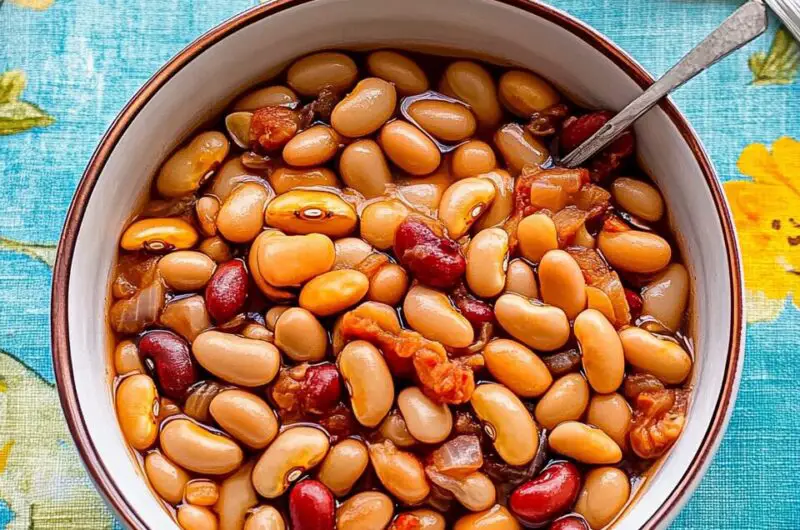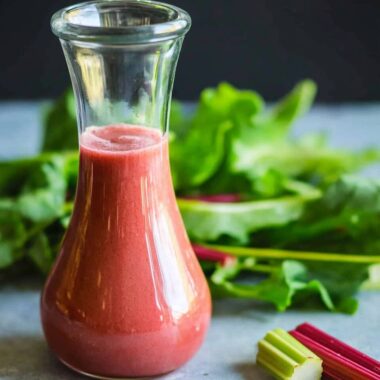Smoky Southern Soup Beans are a simple, comforting dish steeped in Appalachian tradition. This hearty one-pot meal brings together creamy pinto beans slowly simmered with smoky ham hock, onions, and warm spices until tender and flavorful. Serve it with a slice of buttery cornbread, and you’ve got yourself a humble yet deeply satisfying Southern classic. Perfect for chilly evenings, this dish is both nourishing and budget-friendly. It’s a go-to recipe for anyone looking to embrace old-fashioned home cooking with minimal fuss. Whether you grew up with a pot of soup beans on the stove or you’re new to this comforting Southern staple, it’s sure to warm both your belly and your soul.
Full Recipe:
Ingredients:
-
1 lb dried pinto beans
-
6 cups water
-
1 ham hock (or 1 cup diced ham)
-
1 small onion, chopped
-
2 cloves garlic, minced
-
1 teaspoon salt
-
1/2 teaspoon black pepper
-
1/2 teaspoon smoked paprika
-
1 bay leaf
-
Optional: chopped green onions for garnish
-
Optional: cornbread for serving
Directions:
-
Rinse and sort the beans to remove any debris. Soak overnight or use the quick soak method (boil for 2 minutes, then let sit for 1 hour).
-
Drain and rinse soaked beans.
-
In a large pot or Dutch oven, add beans, water, ham hock, onion, garlic, salt, pepper, paprika, and bay leaf.
-
Bring to a boil, then reduce heat and simmer for 2–2.5 hours, stirring occasionally, until beans are tender and the soup is thickened.
-
Remove ham hock, shred any meat and return to the pot. Discard bay leaf.
-
Taste and adjust seasoning as needed.
-
Serve hot with a side of warm cornbread and garnish with chopped green onions if desired.
Prep Time: 10 minutes | Cooking Time: 2 hours 30 minutes | Total Time: 2 hours 40 minutes
Kcal: 280 kcal | Servings: 6 servings
The Soul of the South: Exploring the Legacy of Soup Beans
When it comes to traditional Appalachian and Southern cuisine, few dishes hold as much cultural and emotional weight as Soup Beans. With humble roots, this dish has nourished families for generations, especially in the mountains of Kentucky, Tennessee, West Virginia, and the Carolinas. Simple in ingredients but rich in flavor and heritage, soup beans offer not just a meal, but a story a narrative of resilience, resourcefulness, and rustic charm.
A Dish Born of Necessity
The origins of soup beans trace back to the rural communities of Appalachia, where families often lived far from markets and resources were scarce. This dish was a response to those challenges a way to stretch what little they had into something warm, filling, and sustaining.
Dried beans, especially pinto beans, were a pantry staple thanks to their affordability, long shelf life, and nutritional density. When slow-simmered with a ham hock or scraps of cured pork, they transformed into a hearty, protein-rich meal. The dish could cook all day over a wood stove while families worked, making it ideal for the busy rhythm of farm life.
More than just sustenance, soup beans were a way to bring families together at the dinner table, especially during the cold winter months. The aroma of slowly simmering beans was a comforting scent that filled homes and hearts alike.
Regional Variations and Common Pairings
Although pinto beans are the most common variety used in soup beans, regional adaptations abound. Some cooks use white beans, navy beans, or even October beans, depending on availability and preference. The seasoning is similarly flexible: while some recipes stick to the basics salt, onion, and garlic others introduce spices like smoked paprika, bay leaf, or a splash of vinegar for brightness.
However, what truly defines this dish is its pairing with cornbread. Whether baked in a cast-iron skillet or fried into hoecakes, cornbread is the essential accompaniment. The contrast of the soft, savory beans with the crumbly, slightly sweet bread makes for an unforgettable combination.
Common side dishes include:
-
Fried potatoes or skillet-fried onions
-
Chow chow (a tangy pickled relish)
-
Greens like collard or mustard
-
Sliced raw onions or scallions
-
Buttermilk to sip on the side
This full spread often turns a simple bowl of beans into a full-blown Southern supper.
The Nutritional Power of Soup Beans
Beyond tradition and taste, soup beans offer solid nutritional value. Beans are a plant-based source of protein, rich in fiber, iron, potassium, and complex carbohydrates. When paired with cornbread or rice, they form a complete protein, making them ideal for vegetarians and budget-conscious cooks alike.
The slow-cooked ham or ham hock adds not only flavor but also important minerals like zinc and phosphorus. While the dish isn’t low in sodium due to the cured meat, it can be adjusted to meet dietary needs by using smoked turkey legs or omitting the meat entirely.
For those interested in clean eating or plant-based diets, soup beans can be easily adapted by swapping the meat for smoked paprika, liquid smoke, or sautéed mushrooms to replicate that umami depth.
A Comfort Food Reinvented
In recent years, traditional comfort foods have experienced a renaissance. Dishes once considered “poor man’s food” are now being celebrated in gourmet restaurants and modern home kitchens. Soup beans are no exception. Chefs are pairing them with artisan cornbread, incorporating local heirloom beans, and infusing new flavors while still respecting their humble roots.
This recipe is also ideal for batch cooking and meal prep. A big pot will last for several days, and the flavor deepens as it sits. It freezes well, reheats beautifully, and can even be turned into bean dip, burrito fillings, or a hearty stew with added vegetables and rice.
Tips for Perfect Soup Beans Every Time
While the recipe itself is simple, there are a few key techniques that elevate soup beans from good to unforgettable:
1. Use Fresh Dried Beans
Beans that have been sitting on the shelf for years will never get fully tender. Use beans that are less than a year old for best texture and flavor.
2. Low and Slow is the Way to Go
Soup beans need time. A long, gentle simmer allows flavors to meld and the beans to release their natural starches, creating that signature creamy broth.
3. Don’t Rush the Seasoning
Salt too early, and the beans may toughen. Wait until they’re nearly tender, then season more assertively to finish.
4. Use Bone-In Ham or Ham Hocks
The collagen and marrow in the bone give the broth body and depth. If unavailable, smoked turkey legs or a good-quality bacon slab can work in a pinch.
5. Let it Rest
Like chili or stew, soup beans are often better the next day. The flavors continue to develop, and the beans soak up even more deliciousness.
Cultural Significance and Storytelling
In Appalachian and Southern culture, soup beans are more than just food they are a symbol of community and perseverance. They represent a time when ingenuity in the kitchen was necessary for survival. Grandparents passed this dish down to children, not just as a recipe, but as part of their identity.
Families often share stories over a bowl of soup beans: memories of growing up on a farm, of winter nights spent around the table, of gardens full of dried beans harvested for the cold months ahead. It’s a dish that brings the past into the present, comforting and familiar in a rapidly changing world.
Modern Twists on a Classic
While the original version remains beloved, today’s cooks enjoy putting a modern spin on soup beans. Some ideas include:
Advertisement
-
Adding roasted tomatoes and cumin for a Southwestern flair
-
Topping with crumbled queso fresco and cilantro
-
Mixing in kale or spinach for added nutrition
-
Serving over brown rice or quinoa instead of with cornbread
-
Using an Instant Pot or slow cooker for convenience
These tweaks make the dish versatile and exciting for new generations, while still honoring the essence of what makes soup beans so beloved.
Conclusion:
Soup Beans may be modest in ingredients, but they are mighty in meaning. This timeless recipe captures the heart of Southern cooking resourceful, hearty, nourishing, and meant to be shared. Whether you grew up eating them or you’re trying them for the first time, Soup Beans have a way of making any kitchen feel like home.
By serving this dish, you’re not just filling your belly you’re preserving a piece of culinary history. You’re connecting with a lineage of cooks who turned simple ingredients into something extraordinary. And best of all, you’re creating your own stories and traditions to pass down.
So the next time you crave warmth, comfort, and a taste of home, put on a pot of soup beans. Let them simmer low and slow while you go about your day and when it’s time to eat, savor the flavors and the memories that come with them.








